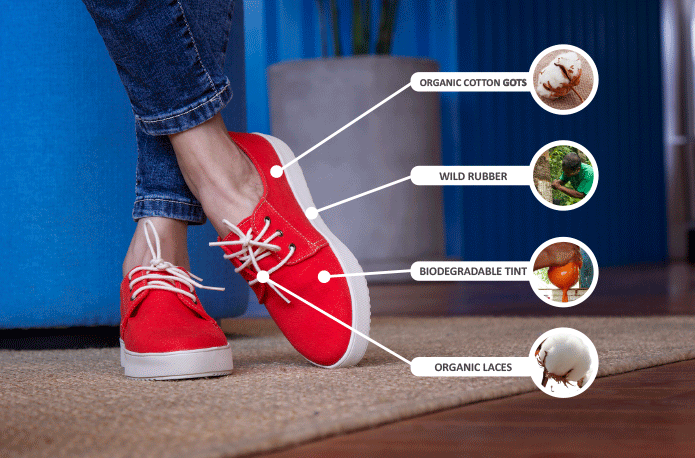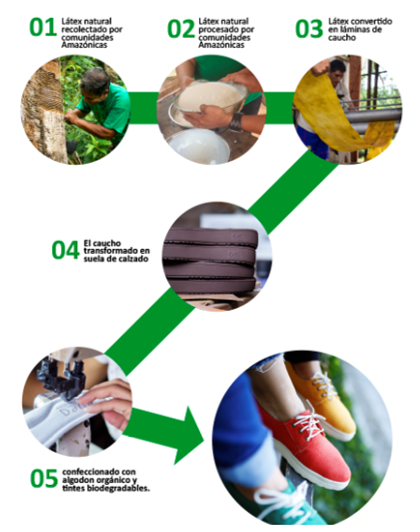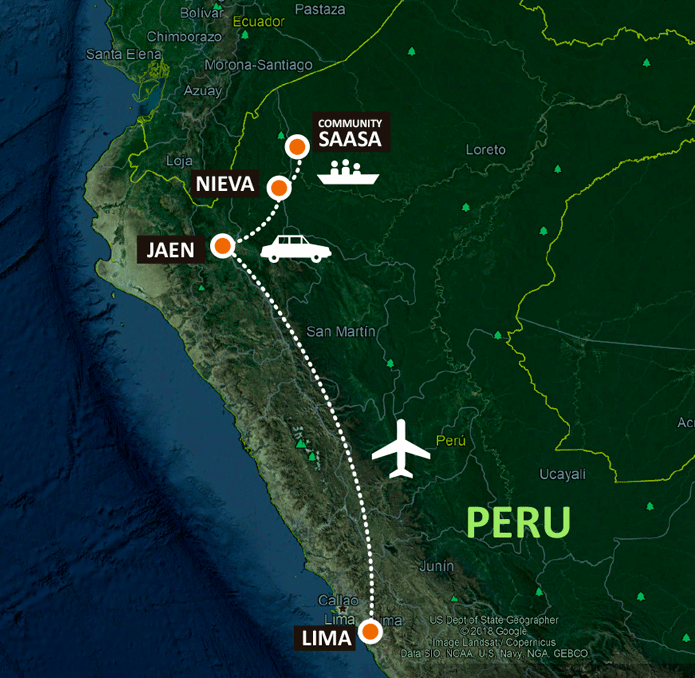Forest Conservation and Amazon communities development through research and sustainable fashion
Description
In Perú is deforested per year 150 000 hectares of forests. Evea empowers communities and develop products from biodiversity to stop the deforestation. We focus our efforts promoting sustainable fashion to protect the Amazon forests. In our effort, we include the LCA study to measure our impact on our production and show in Perú how can we reduce our carbon footprint.
* Conserve 1856 hectares of forest in the Amazonas region<br />
* Put in value 1479 Silvestri rubber trees in the Amazonas region <br />
* Empower 17 families of the Awajun ethnic in the jungle from 3 communities to increase their incomes by 45%.<br />
* Measure the carbon footprint and water footprint of the Evea Shoes using the Life Cycle Assesment process<br />
* Promote the sustainable fashion to preserve the forests in 3 events in Perú.
AMSP: Peruvian Sustainable Fashion Association. We are part of the network and be part of the communication events to promote sustainable fashion.
Sernanp: Peruvian Natural Areas Service. With them we connect with Amazonas and communities.
Environment Ministry: We are part of the catalog. This space promote the sustainable brands in Perú.
SIMBIO. Italian organization, they realized the LCA Study
SERFOR: They support us to participate in research founds in biodiversity
Initiation: At the beginning, I had a journey to the Peruvian jungle. In that experience, I saw the beauty of the Amazon but for other parts the great challenge: the deforestation. My first mission was the articulation of rubber to Lima Industries. When I accomplished the task I returned and thought about the possibilities to create more products with rubber to still work with Amazon communities.
Planning: The plan consisted in the creation of sustainable casual shoes from the eco-design method. Using the wild rubber into the sole, organic cotton and biodegradable tints to reduce the carbon footprint and protect the forests areas of the Awajun that provide the rubber. The creation of the product needed the workshops with the Awajun communities to assure the quality of the material.
Execution: The product at the beginning had problems with the chemical formula because the color of the sole changed of color to yellow. They with the research of the best option of chemical formula the product assured the stability to start with the sales. The rubber has a process that includes the work with the rubber tapper since the jungle. In that part, the workshop provided the mindset to work the best product to preserve more forests.
Monitoring Mechanism: We use the following methods:
* Foresta Management Plan. These documents have the GPS location of each rubber tree. We visited the spaces sample to look at the conservation of forests.
* Invoice and intern documents: Whit the documents of payments to the rubber tappers we saw the increase of the rubber tapper incomes
* LCA Study. This study provides us the numbers of our impact when we produce Evea shoes.
* Result of LCA Study of Evea Shoes (Pending Critical Review)
* The visits to the Amazon communities to look the process and the forest preservation testing different locations.
* Expositions in Events realized to promote sustainable fashion: Fashion Cafe November 2018, Sustainability week - Usil 2018, ExpoTextil 2018, TLS - Toulouse Lautrec Event - Misión Ecuador 2019
With the sustainable shoes line we can assure a growing using the marketing tools to increase our market penetration. More sales will provide more options to work with more Amazon communities and preserve more forest areas in the Amazon.
The Peruvian government has started promoting natural areas through different methods of protection. Research, tourism, and economy growing. In that part programs as Startup Perú provide us an important ally to raise money to support the project.
The importance of the research to adapt the products from biodiversity is fundamental. We understood that we must to test and test until the product was ready. As a scientific method, is important to be perseverant and keep calm when the results are not the best that you wait.<br />
<br />
Is important to create the process, with more efforts when your model can be replicated.<br />
<br />
In the Amazon, we can find amazing possibilities of food, materials, medicines an others, but first, we must protect the biodiversity, and in that effort the Amazon communities through the sustainable work can protect the forests and assure the biodiversity to the world.
https://www.youtube.com/watch?v=vjn3MpeFGV8
https://greenandtrendy.com/evea-ecofashion-salvando-el-amazonas-con-lat…
http://revistaganamas.com.pe/evea-ecofashion-gano-premios-latinoamerica…
http://economiaverde.pe/pymes/evea-eco-fashion/
https://www.conservamospornaturaleza.org/carnet/evea/
http://blog.es.idealist.org/tag/evea-ecofashion/
http://www.premioslatinoamericaverde.com/proyectos/evea_eco_fashion_2017
http://yabt.net/es/noticia.php?n=tic-americas-2018-winners
SDGS & Targets
Deliverables & Timeline
Resources mobilized
Partnership Progress
| Name | Description |
|---|
Feedback
Action Network


Timeline
Entity
Region
- Latin America and the Caribbean
Geographical coverage
Photos



Website/More information
Countries

Contact Information
Cristian Gutierrez, Cofounder
